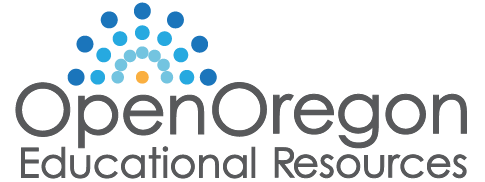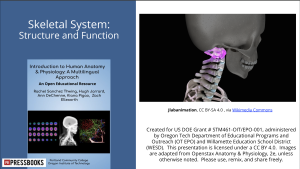Lesson 1: Functions of the Skeletal System
Lesson Slides
Functions of the Skeletal System
The skeletal system serves many critical roles in the human body:
-
Support: It provides a rigid framework that supports the body against gravity.
-
Protection: It protects soft organs, including the brain, spinal cord, heart, lungs, and pelvic organs.
-
Movement: It serves as an attachment point for muscles, allowing movement through biomechanical levers.
-
Breathing: It contributes to respiration by providing the thoracic framework for diaphragm movement.
-
Mineral and Fat Storage: It stores calcium, phosphorus, and fat in bone marrow.
-
Blood Cell Formation: It is the site of hematopoiesis, the process of forming blood cells.
-
Hearing: It transmits sound vibrations from the eardrum to the inner ear.
Let’s explore each function in more detail.
Support and Protection
The skeleton provides the structure necessary to support the body’s weight and posture. Bones also protect vital organs:
-
The cranium surrounds the brain.
-
The vertebral column encloses the spinal cord.
-
The thoracic cage (ribs and sternum) protects the lungs and heart.
-
The pelvic bones protect reproductive and urinary organs.
Movement and Leverage
Muscles attach to bones and pull on them to create movement. Each muscle has:
-
An origin (the fixed attachment point), and
-
An insertion (the moving point, pulled toward the origin).
Bones and muscles work together using three classes of levers to produce motion.
Role in Breathing
The thoracic cage provides a rigid structure for the diaphragm to pull against. This action increases the size of the thoracic cavity, allowing air to flow into the lungs during inhalation.
Mineral and Fat Storage
Bone tissue stores calcium and phosphorus, key minerals that help maintain homeostasis.
-
When blood calcium levels drop, the hormone parathyroid hormone (PTH) stimulates osteoclasts to release calcium from bone.
-
When calcium levels rise, PTH levels decrease, and calcium is deposited into bone.
Bone marrow also stores fat, which serves as an energy reserve.
Blood Cell Formation (Hematopoiesis)
Bone marrow is responsible for producing:
-
Red blood cells (erythrocytes)
-
White blood cells, including immune cells like T and B lymphocytes
-
Platelets, which are essential for blood clotting
This process occurs in response to chemical signals that trigger blood stem cells to mature into specific blood cell types.
Conduction of Sound
Three small bones in the middle ear (ossicles) transmit sound from the tympanic membrane (eardrum) to the cochlea in the inner ear. This biomechanical system amplifies sound vibrations and converts them into nerve impulses that are interpreted as hearing.
Types of Bone
The skeletal system is composed of two main types of bone:
-
Compact Bone
-
Spongy Bone
Compact Bone
Compact bone is dense and forms the outer layer of all bones. It is composed of repeating units called osteons.
Each osteon contains:
-
Concentric lamellae: Circular layers of calcified matrix
-
A central canal: Carries blood vessels, nerves, and lymphatic vessels
-
Lacunae: Small cavities housing osteocytes (mature bone cells)
Osteocytes maintain bone tissue and receive nutrients through tiny channels that connect to the central canal.
Spongy Bone
Spongy bone is lighter and found inside bones. It is made up of a porous network called trabeculae.
Although it lacks true osteons, spongy bone still contains:
-
Lamellae arranged in irregular patterns
-
Lacunae with osteocytes
The open spaces in spongy bone often contain bone marrow, making it important for blood formation and fat storage.
These are the Module 3, Lesson 1, Functions of the Skeletal System OER Revised slides, available as a PDF that you can open on your phone and zoom in. And as a Google slide deck: Module 3, Lesson 1, Functions of the Skeletal System.
Practice Questions
Use these practice questions to assess your knowledge before you move on to the next section.
Try this crossword puzzle for more practice!


